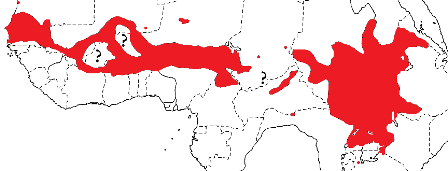Weaver Wednesday [50]: Little Weaver 2013-05-29 (370)
 Weaver Wednesday
Weaver Wednesday


The Little Weaver Ploceus luteolus is one of the smallest weavers, and is found in the savanna belt from West to western East Africa. The male in breeding plumage has has a black forecrown, face and throat surrounded by bright yellow, without any of the saffron wash typical of larger weavers. It may be separated from the similar Slender-billed Weaver P. pelzelni by its dry woodland habitat, and much shorter bill (14 vs 17 cm). It is distinguished from the Lesser Masked Weaver P. intermedius by its brown, not white, eye. The female and non-breeding male are yellowish.

The Little Weaver occurs from West Africa across to Ethiopia and Eritrea, and south to Lake Victoria (see map left, based on Birds of Africa). Two races have been proposed previously, but the species is currently treated as monotypic.
The Little Weaver inhabits savanna woodland with large Acacia trees, open scrubland with small trees, edges of
farmland and large gardens, arid thornscrub and red sandy country. It is not gregarious; usually being in pairs, sometimes singly or in small flocks.
It feeds on seeds and insects, including small beetles and caterpillars. The Little Weaver forages mainly in acacias and other small trees, working methodically through the foliage. It sometimes feeds on the ground, and may forage with
waxbills.

The Little Weaver is a monogamous, solitary nester and rarely, in colonies. A pair often returns to the same site in successive years.
The nest is a globular structure with a short, vertical entrance tube at the side. The nest is densely woven by the male using fine, narrow herb and grass stems, grass blades, palm fronds and small vine tendrils. The nest is lined with grass seedheads and other fine material. The length of the entrance tunnel varies from 50 to 300 mm. The nest is suspended from thorny branches of small trees, often close to occupied wasp nests. Nest construction takes 3-4 days. The male may continue working on the tunnel, even after breeding has ended. The 2-3 eggs are plain white, ovate, and slightly glossy.
The Little Weaver has 2 PHOWN records, one from Gambia and one from Uganda. Many more PHOWN records are needed for this locally common species (see PHOWN summary). Two active nests in Ghana were taken over by Red-cheeked Cordon-bleus Uraeginthus bengalus, so look out for birds taking over Little Weaver nests. Submit any weaver nest records to PHOWN (PHOtos of Weaver Nests) via the Virtual Museum upload site.
PHOWN summary
Previous Wedn: Red-headed Quelea
Full weaver species list
|


 Weaver Watch
Weaver Watch


